#surprise jerma
Text
jerma getting everyone killed with his pacman bit
(group POV in replies)
#jerma#jerma985#lethal company#im genuinely surprised no one uploaded this yet#graves speaks#vinesauce#ster#pokelawls
1K notes
·
View notes
Text

Sam & Max
#been watching jerma's playthru of the 2 seasons and im loving them so much#i love their chemistry. i like max a little more but im also pretty fond of sams straightman..nedness#i expected not to like sam much bc i usually like the little guy more in duos. but its a pleasant surprise that i like him just as much#sam and max#my sketches#sam and max freelance husbands#AHDRASHJFBASJ THIS IS A TAG????
682 notes
·
View notes
Text



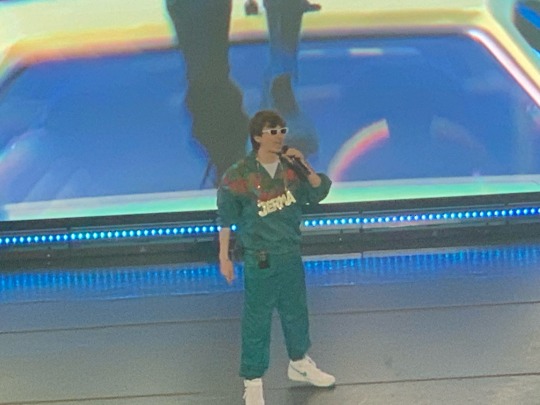
THE JERMA DRIP GOES HARDDDD AF
#I looked away from the streamer awards for. one second and looked back and choked on my pizza ;—;#this was so fucking funny tho if jerma was the one that planned this bit I would not be surprised. +2 from me#jerma#streamer awards#thing
148 notes
·
View notes
Photo

Let’s go gang new Demily outfit just dropped. 🤟
#demilypyro#demily art#demily#demily fanart#doodle#vtuber#fan art#chibi#chibi art#the boots were improvised i wanted to give u some cute ones#also fun fact for some reason im working better when listening to the Rats Birthday song by Jerma#i dont know what that says about me but im surprised i got this out with the song playing for an hour
1K notes
·
View notes
Text

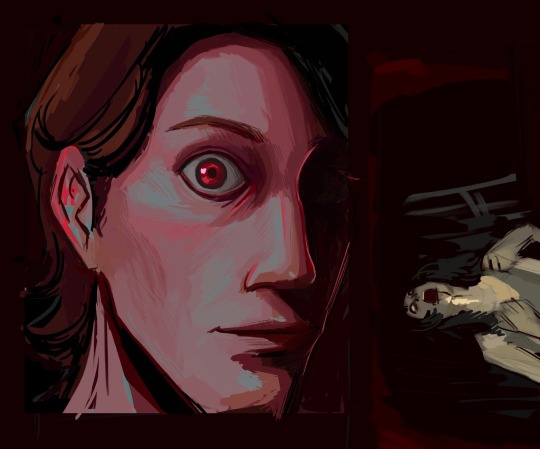
frgot to post these here happy halloweenie 🎃
#jerma#jerma985#i posted these on twt a week ago or smth#i was surprised ppl rly liked em it was nice#jerma fanart#tw blood#tree art
328 notes
·
View notes
Text
sssshhh. they’re communicating
#jerma#jerma985#surprise! I found this note in my notes and I was like. why. and did it anyways#drew gooden#who won the bark off?
78 notes
·
View notes
Text
Jerma talks like he's constantly pretending to be on a phone call
#smokey talks#jerma#im watching him play elden ring and hes like#'i wanna go to the middle. i wanna go in the middle. yeah. theres an item there. yeah in the middle im trying to go the middle. yeah.uh huh#he is infuriating 2 watch sometimes actually bc he just... does not pay attention and chat likes 2 lead him astray intentionally#he perpetually ignores things he himself says out loud seconds after saying it#hes funny tho#silly fella. i like his videos#hes also prone to just. confidently asserting wrong things based on almost nothing and then being surprises when its wrong#but i think thats. at least partially a shtick
19 notes
·
View notes
Text
A Narrative Designer Dissects Generation Loss
(And Further Thoughts on Dollhouse-like Streams)
I keep saying how Jerma's ushered in an entirely new narrative medium and no-one's believed me.
This has been stewing in my mind for months. Ever since watching The Dollhouse Stream while going through a bout of just-got-my-second-covid-shot fever, one thought has carved itself on the inside of my skull. It is something I truly believe, and am baffled that more people aren't talking about.
Livestreams are evolving into an interactive narrative artform.
Generation Loss has only cemented this for me.
This is something I will keep yelling from the rooftops until my throat is sore, and this essay is my desperate attempt to get other people to start paying attention to interactive livestreams.
Livestreams as a Medium
By definition, a livestream is anything broadcast over the internet to a live audience. Over time this has generally fallen into a standard format thanks to the community of livestreaming centred around Twitch, of a livestreamer playing a video game with a live chat engaging in the experience in some capacity. This is to the point that someone who describes themselves as a "streamer" will come with the assumption that they play games for a live audience.
However, this is a flexible format, and doing out-of-the-box livestreams is nothing new. Stream team Radio TV Solutions are infamous for putting on weird, absurdist, and even genre-bending takes on playing games for audience entertainment. Some of their streams can be likened more to a live broadcast show, rather than a simple "gaming stream".
But, what we're focusing on here are interactive livestreams, and not just streamers taking an interesting spin on the format. Such examples are the likes of Charborg, presenting his chat with a question, with individual members voting on a response, to then be dragged at random into a literal court of opinion to debate the reason for their choice. He puts his audience directly in control of the stream and its direction, with both streamer and chatter having to "roleplay" into the experience.
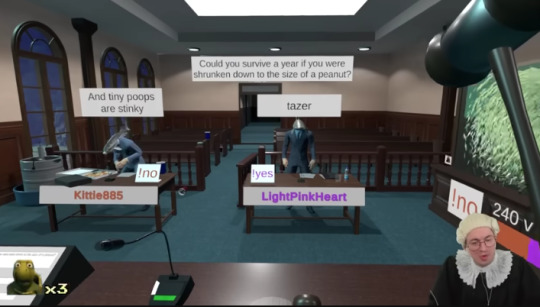
Interactive livestreams even extend beyond Twitch's roots of gaming content. Alistair Aitcheson is known for his interactive art streams, where he creates paintings with direct input from the audience watching. Here, the audience decides what Alistair should do and how he should do it, whether that be drawing a black cat, only being allowed to paint with his elbows, or using mayonnaise as a pigment.
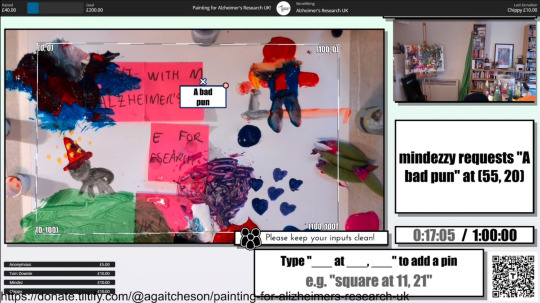
But, by far, the most famous player in this space is streamer and former TF2 creator (of which, as someone who's been a fan of his since 2012, am shocked that more people don't know) Jerma985. Over time, Jerma has become known for his "big streams", where he will do anything from broadcasting a fake family dinner where everyone but Jerma is an actor that have never met each other, to digging up rocks in the Nevada desert in collaboration with a local science institution, to organising an entire baseball game of half actors and half actual athletes, complete with a full live commentary.
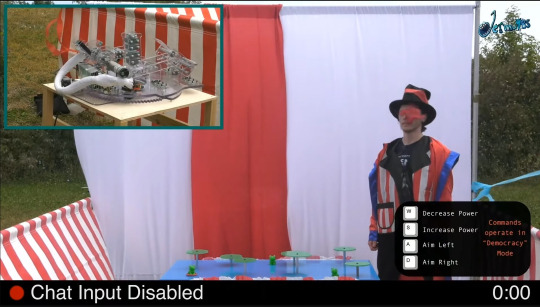
In 2019, Jerma broadcast "The Carnival Stream", a defining work for interactive livestreams. Jerma played the role of a ringmaster, bringing his chat around various carnival games that could be played with Twitch chat-powered robots. Almost immediately it became a sensation, and put Jerma down as one of the most innovative livestreamers to date. It was something Twitch had never seen before. Truly, no-one was doing it like Jerma.
At this point, livestreams are a medium that are going through radical innovations. People are doing interesting things with the concept, experimenting with what you can and can't do, and pushing them into new and fascinating directions of entertainment.
How do you turn entertainment into an artform?
The Impact of the Dollhouse Stream
During my undergraduate, my professor told me one thing I've held dear to my ethos ever since. Discussing the ways narratives are woven into video games, he said:
"The difference between a toy and art, is that art is able to tell a story."
It's a measurement that's never failed me. Everytime I've looked at something, and wondered if I could call it art, I remember this. Art is made through narrative. And one thing I'm always fascinated by, is if a medium can tell a narrative uniquely compared to others. I develop games fulltime, and both my studio and solo projects are focused on how to most effectively tell a story through whatever means it finds itself in. Interactive narrative experiences are something I hold very dear.
When Jerma announced "The Dollhouse Stream" to broadcast in 2021, the hype was electric. By now Jerma's big streams had become an internet sensation, even to the point of being affectionately dubbed "The Superbowl for the gays". With the only information on the stream being something influenced by The Sims, taking place over three individual broadcasts, tens and thousands of viewers tuned in to watch.
What we saw was, I truly believe, the beginning of livestreaming turning into an artform.

The Dollhouse Stream took interactive livestreams in ways that have never been seen before, and it's an absolute marvel that it exists at all. It was brilliant, hilarious, and absolutely groundbreaking.
And, there was a plot.
It was a loose plot, and just served as a way to funnel more shenanigans on screen, but it existed and fulfilled the exact purpose it was set out to do. There were defined beats, a set way it was going to end, and the interactive elements were giving a unique experience on how we'd get there.
This is where I felt my fixation latch. This could be a new narrative medium.
I prayed, and hoped, this was just the beginning of streams like this.
An Analysis of Generation Loss as an Interactive Narrative
(And Other Parts that Caught my Attention)
Disclaimer: Any critiques in this section are given entirely in good faith, and have no bearing on the immense amounts of work by those who worked on Generation Loss. This comes from me believing with my whole heart that interactive livestreams could, and should, be judged as an artform, and thus subject to the same level of critical analysis.
My prayers for more were answered when Generation Loss was announced as a "live interactive horror show". I decided to go into the stream blind, for better or worse, only knowing that the stream was based around horror, and almost certainly would be set in its own self-contained narrative. There was supplementary media around it to hype the stream up and flesh out the story around it, but I wanted to see how well this could stand on its own, and if interactive livestreams really could be the new narrative medium I was hoping they were.
Episode One
was absolutely not what I was expecting.

The tonal whiplash I felt on realising this was being played as a comedy is not something I'm quite able to describe.
This doesn't make it bad; far from it. In retrospect it's a perfect intro to the slow descent from light-hearted comedy romp that's almost self-aware into a serious psychological horror.
Being familiar with The Dollhouse Stream, the structure is almost identical, with an audience presented with a choice, going to a timed vote, and having the choice with the highest percentage play out in whatever ways it might. Between beats of the audience picking a choice and seeing its consequences, the downtime is filled with the streamers reacting to the choices, shooting the shit, or guiding the stream through scripted plot beats.
But Generation Loss takes it in a slightly different direction. The Dollhouse Stream is based on life simulation games, with the audience trying to keep Jerma alive (or, most of the time, deliberately starving or exhausting him to see what would happen), earning money to buy furniture, upgrading the house, and sitting back to watch the chaos they've inspired.
Generation Loss, however, commits to the theme of an adventure game. Ranboo wakes up in a cabin, realises they're stuck in there, and we're presented with the first choice of picking somewhere to investigate, and later learning that we have an inventory. There's no objective, beyond a vague semblance of knowing we need to get out, and having to explore to find out what we're supposed to do. As the audience we have direct control over his actions, and decide where Ranboo should search next, guide him through various puzzles, and help him out of precarious situations.
Once I settled into what I was watching, the stream was great. It kept up the pace, everyone was hilarious, played into its cheese, and was a solid take on an interactive livestream.
But, the one thing I was hoping for wasn't there, with interactivity that was played with in interesting manners. It was fairly obvious that every choice would lead us to the same, if not a similar outcome. With The Dollhouse Stream, Jerma choosing to flirt with someone rather than simply talking to them could have huge impacts on where the day-to-day plot would go, and how everyone else responded to it in turn.
After some thought, I settled on this being episode one. Something new could be coming in the future, and there was no way the advertising banked this hard into horror to just be a simple comedy setup. This episode was a great start, made good use of interactive livestreams as a medium, and made me cautiously optimistic for the rest of the series.
Episode Two
Starting episode two, it took me all of three seconds to recognise the Saw inspiration and know exactly who would be behind it.
For those who haven't been following Jerma for long enough to cause permanent damage to your psyche, Jerma has an ongoing joke of putting on an audio filter and speaking like Jigsaw, running through bizarre or entirely mundane takes on Saw traps. This all stemmed from one House Flipper stream, which quickly spirals into an insistence that the Saw movies have an obsession with neurotoxins and nerve agents, which chat is very quick to disprove, and the legend of GYAS is born.
So as a Jerma fan, witnessing the culmination of a years-long bit, this was fucking hilarious.
But as someone looking to this series as a new narrative direction for interactive livestreams, I started to get a little concerned. It seemed to be hitting much the same points as The Dollhouse Stream, without really pushing into new fields on the narrative side. Perhaps "horror" was mislabeled, and "comedy horror" might have been a more apt description. Critically, maybe the angle I'd like interactive livestreams to be taken in wasn't the intent of this series. It was definitely enjoyable, but maybe I was looking for something that wasn't put there in the first place.
The moment that turned it around was this:

This is when Generation Loss became what I was looking for.
Everything about this moment works spectacularly. Charlie's almost immediate transition from silly jokes about toy racing cars to guttural screaming; the delayed, almost confused reaction from Ranboo; the cut straight back to the jokes, leaving the audience to digest what just happened, alone, with no-one on screen to help us through it.
This simple 10 seconds made the entire episode work. We now have a frame story. What we're seeing isn't reality (and as we later learn, is a literal show), and occasionally we see through the gaps in the curtain. Suddenly, the goofiness can be leant into. We can lean into it as hard as we want; there's no bearing on what's actually happening. Then you're sat there, laughing at streamer shenanigans and jokes, with a subdued sort of horror that you'll never know when the curtain will be pulled back again.
My main wish for this episode was that the curtain was pulled more effectively. Each streamer more than adds to the comedic side to the stream, then when it was pulled (or at least, when I assume it was), I don't think it landed as well as the operating table.
Some examples are the deaths. Ethan's stands out to me, as one that gives me some of the most mixed emotions. Just as itself, watching Ethan die off-screen, only hearing his voice, while Ranboo and Sneeg stand and barely react to it in stark contrast to Austin's panic, works extremely well if you look at it as a scene out of context.
The problem is, I think it breaks an established rule. The rule being, as far as I can tell, that while the show is running everything is seemingly inconsequential. Once Ranboo wakes up, and both of us learn of the show masking everything, we're free to see the reality under it, making us more similar to each other than he'd like.
On the operating table, we're given a precedent for what green slime actually is. Now, any time we see it, it's in a very different light, and entirely recontextualises the first episode.
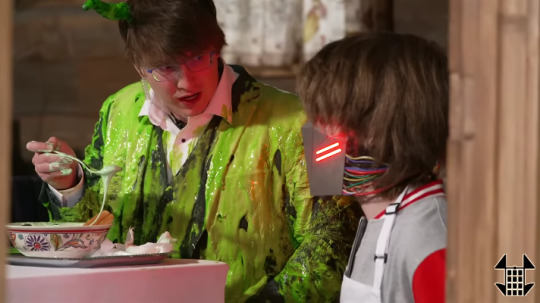
But now when Ethan dies, we... do see blood? I was under the assumption that blood was censored on the show in some capacity, and the glitches are the show breaking down and getting a brief slice of the reality of the situation. If it isn't, what happened with Charlie? Did this one death in particular make it through the censors, for some reason? Did it have something to do with the setting adjusted on Ranboo's mask before this room was hit? If so, it seems like a bizarre choice, both in-universe and for the narrative impact it had.
We return to some of these spots in the next episode. It feels like a missed opportunity to not play off these moments as a fake-out on the show-side, and then discovering they were actual deaths when the reveal's made. Instead we have people dying in gruesome manners, to then reveal they're... still dead. It's an alright reveal in the context of the line between reality and fiction being blurred, but one that could be much stronger.
All of this isn't to say that every death needed a moment where the line between show and reality is crossed. Vinny's death is a perfect example. It's a full Looney Tunes bit of being (literally) ragdolled across a room, with cartoonish fanfare, and then met with a hilarious demise of being hit in the head with an anvil. The reality of this... I like that being left to our imagination. It's a good one.
The death I felt was the weakest was the combined deaths of Austin and Sneeg, getting crushed by a moving wall cutout Ranboo manages to fit through, of which, through many ways that are immediately obvious, could fit several people through with some amount of problem solving.

Was this... funny? Absurd? Are we supposed to laugh? It's played in a goofy manner, definitely, but this was just after Ethan's death. We already know these people are dying by this point, or at the very least grievously harmed, so having two people die in succession to then be immediately swept under the rug was odd. After Niki's death, which accomplished a shock death that's moved on from almost immediately very nicely, it felt like a backtracking in tone and redoing a beat we've already seen.
On top of that, Austin reacted to Ethan's death, and then to the continued lack of reaction Sneeg and Ranboo have. I took this as Austin no longer being controlled in some capacity, so it doesn't make that much sense for Austin to die in a way that has a logical way out. Sneeg's does make sense, having been fully put under again. And going back to the point of the green slime, wouldn't it be much more effective if Ethan died in a way that isn't seen, perhaps only briefly and then cut off, to then see Austin freaking out over "nothing"?
I felt a bit of dissonance. Maybe this was the intent, but I don't think it landed in the right way. Instead of thinking if I should be concerned if that was a real death or not, like Niki's, I was more wondering if I was supposed to be thinking that. I was confused rather than horrified.
To give my fair dues, the moment with Sneeg realising where he was, and his attempted escape, was really good. It's a subtle moment at first, only shown by a glitch and Sneeg snapping out of an apparent fugue, to try to find his way out while pretending he's still under it. Our next curtain pull is Sneeg being dragged back into the show to be reset again while everyone's frozen, which I only fully caught on a rewatch as a literal pause of the show.
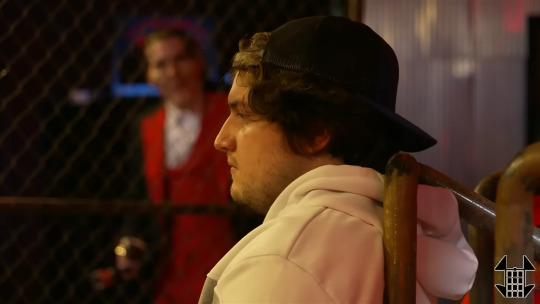
Another part of this episode that weakened it was something I didn't even realise would be an issue with interactive livestreams. With The Dollhouse Stream, if someone went on a bit of a joke tangent before moving onto the next part, it was fine. You're here to laugh and it only played into the strengths of the whole thing being a comedy setup. You're going from one thing to laugh at, to another thing to laugh at, and now you're on a detour for something else to laugh at that wasn't fully planned. The beats feed into each other.
But with Generation Loss, I was wanting everyone to move on so we could see the next horror beat. I wanted to be on the edge of my seat wondering what's going to happen next, and instead I was waiting for this line of jokes to wrap up. It was funny, because these people are full-time entertainers, but I didn't want to laugh right now.
Even with that said, I'm honestly not sure where that line should be. One part of me thinks this episode would be much for the better with some tighter pacing, but another couldn't bear to not have my heartstrings pulled by fulltime gay Austin's four children. Not even mentioning his one wive.
And wrapping up what I thought would be a small tangent before I get to the reason this essay exists in the first place, even with some tonal inconsistency and downtime between beats, I adore the details in this episode you only catch on a rewatch. For example, this tiny moment in the second to last room, where Ranboo is tapping out a morse code SOS signal with one hand, to then stop himself with the other.
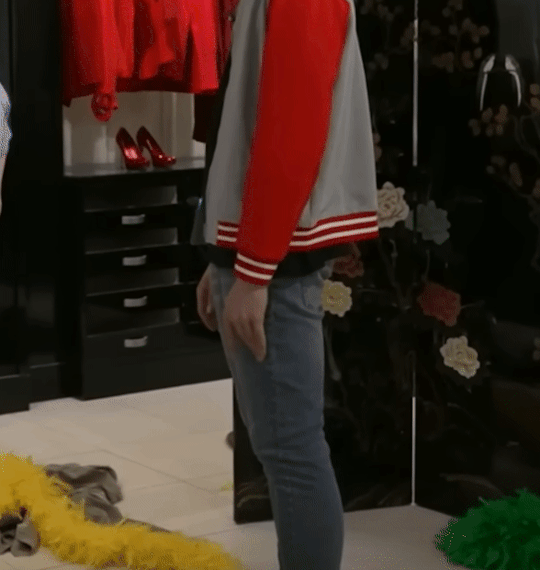
Now that's sick.
Right; let's talk about why I'm here.
I was delighted to see that in this episode we got some neat interactivity that did have some narrative knock-ons. I was, finally, seeing what I came here for! Thrilling!
The critical moment of interactivity is the carousel, at least for the narrative, of which we get to choose two people to save and bring with us for the rest of the episode.
Yes, of course, our choice to save Niki gets her killed, but isn't it nice to play a part?
If we chose someone else, we could have got some pretty different improv sections or possibly new plot beats entirely. It's a good way to add some narrative branching while still progressing through a defined story with one ending.
The other interactive portions of the stream lean into one of my favourite parts of narrative design, of tying game mechanics to the story you're telling. Where the first episode takes on the style of an adventure game, the second is more akin to a gameshow. "Show" is the key word here, and the crux of the whole frame story this episode introduces. We're watching a silly little show, with some silly little entertainers, playing some silly little games that have absolutely no bearing on any possible reality. At all.
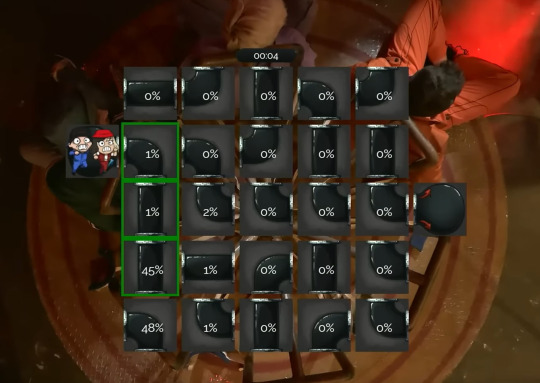
And since we're entertaining ourselves with something so mindless, not really caring about what's happening behind it, some equally mindless and pointless games would be a perfect supplement for this show. At first I wasn't a fan of these game sections, until I started to think about why they'd be put there. It's padding. A distraction. It literally covers the entire screen, demands your full attention by not allowing the story to continue until it's done, all to take your mind off what you're looking at and any discrepancies you might have seen before. It's not obvious, initially causes some friction, and really elevates the medium it's in once you start thinking about it a little deeper.
This is what I'm here for; this is the potential I saw.
With a very nice ending to round it off, and a full reveal promising the horror to run deeper as we continue on, my cautious optimism on how this would be wrapped up persisted.
Episode Three
Episode three is the tonal peak of the series, and by far the strongest episode. It strikes the perfect balance between humour and horror, and really shows the strengths of interactive livestreams as a narrative medium.
It starts almost immediately where we left off from the previous episode, tilting further away from comedy, and then sets us on a slow descent into absolute horror. This progression is done wonderfully. There's even a few sporadic jokes that land during the shift, before committing to it entirely by the ending.

My worry was the overarching story would not land. That there would be one huge lore dump explaining every detail of this corporation behind everything we just had to know. Instead, it's kept pleasantly vague with enough details for us to fill in the blanks from the previous episodes, and add some fantastic context that makes the whole series' worldbuilding stronger.
And a genuine question, did Charlie get acting lessons at some point? His swaps between goofs and terror are stunningly natural and lad's got some pipes on him that fully convinced me he was scared for his life.
Subtlety is the last thing I expected to be impressed by during this. Instead of having its messages laid out explicitly by one character going on a years-long monologue, they're told through environment, character reactions, and from details we've caught previously. Instead of spelling out a message on how streamer personalities are seen by others, you can show us a literal commodification of going live from derelict storefronts.

Cross-stream invasions will never get old. Ever.
This episode is where the series starts to make a fantastic use of every part of the medium it's in. Namely, as a filmed medium, between excellent shots of the live portions, especially during the chase scenes, to some near-seamless cuts to the prerecorded cinematics.

This is the first livestream I've ever said: "Wow, the cinematography's fantastic."
And hilariously, for the episode that ended up being my favourite, is the one with the least amount of actual interactivity. There's only two choices the audience makes, and both are extremely well-placed and well-done. It shows so well how it's not how much interactivity you shove into a medium that enhances it, but when and why you use it.
The first one is a subversion. Everyone loves subversions. We make a choice, but Ranboo now ignores us entirely. By doing so, and revelling in his newfound freedom, Ranboo condemns himself with the wrong choice.
Is it better for us to be in control of Ranboo? Should we be?
There's even subtle storytelling that doesn't come from an interactive moment directly. One happens during the final cinematic before the last choice. This one tiny moment, that I didn't even realise was there until seeing brief mentions of it in chat.
There's an exit sign that Ranboo misses.

And, critically, there were people in the audience who didn't.
Consider us, as we were controlling Ranboo before. There very well may have been moments Ranboo would have missed entirely if not for our choices to bring them there. If we were still in control, could we have sent them that way? Would we have been able to? Would it even be considered a freedom, if he didn't make the choice to reach it?
We're now forced to watch him head to one inevitable fate, just as he watched everyone before him.
The second, and final choice, is the climax of the entire series. Ranboo's final send off, after the show's had its run with him, is up to the audience to decide if he should live or die. Even after managing to be free of audience control, to the point of actively rejecting it, Ranboo is still beheld by it to the very end.
There's even a narrative element to seeing the decision shift in real time, told entirely by the audience watching. Chat immediately floods with attempts to save Ranboo, the knee-jerk reaction on being faced with the option to kill them. Then, as the announcer details the actual fate of being left alive, with Ranboo's slow realisation that they'd consider it worse than death, the bar slowly creeps over to the right, flicking back and forth over the 50/50 mark.
And then, as the choice times out, deciding to give Ranboo an apparent mercy, chat is immediately flooded with laments on if it was the right call as the credits roll.
Absolutely stellar.
This is, for all intents and purposes, the first ever narrative-heavy interactive livestream. It's the best one because it's the only one. There's wanes and waxes, with parts that didn't land, some that very much did, and an experience that I still enjoyed immensely, if not mostly on the novelty of the medium, and the obvious heart that was put into every part of it. Quoting myself to a friend minutes after the stream ended:
"i feel like i just watched the second movie ever made"
And, should Ranboo, Jerma, or literally anyone else pursue narrative-heavy interactive livestreams further, there's so much that could be learnt from and expounded on into something incredible.
That excites me. That really excites me.
Interactive Livestreams as a Narrative Medium
This begs the question: where do we go from here?
I'm pulling away from Generation Loss specifically, and now asking to the question of narratives in interactive livestreams in general. Could we consider interactive livestreams a new narrative medium? Or is it a subgenre of another type of storytelling, with much the same considerations and impacts?
What we're really asking, is this: how does an interactive livestream tell a story through audience interaction? One of the best ways we can do this, is to start making comparisons between interactive livestreams and other mediums, and seeing what lessons we can and can't learn from them.
So, with this in mind, what medium is one of the most famous and wide-spread types of interactive media? What medium is an intersection of many others, and is able to use their strengths and limitations as a story demands? What medium has decades of experience in narrative agency and responding to the choices of someone engaging with it?
Video games.
The Narratives of Interactive Livestreams
Let's analyse The Dollhouse Stream as we would a piece of interactive fiction. It already has many terms describing narrative structures and systems, and the progression of The Dollhouse Stream fits quite nicely into them.
We're going to jump to the first choice made in the house itself in episode one, where the "game" begins proper. There's intricacies happening right up to that point, but we'll discuss what they are in more detail shortly.

The audience's first choice, between working out, going outside, and using the toilet, is exactly the one you think it is. Ignoring the innate comedy of piss, a choice is made, some amount of content happens, and then the stream continues on until the next choice.
This is what's known as a "bottleneck", where a choice branches out, and then collapses back down to a main branch. This main branch, typically dubbed "the golden path" (GP), is the path with the most content, the path a designer tries to guide the player down for narrative satisfaction, the "win condition", or other similar denotation. How the GP is defined exactly depends on the type of story being constructed.
So here's a question: what's the GP of an interactive livestream?
This is where analysing interactive livestreams in this way can only take us so far. The thing is, this idea of branching out and bottlenecking, implies that after the bottleneck, the stream would progress the exact same no matter which choice was made. This is decidedly not true, for many apparent reasons that I'm sure you can see. In an alternate vote where, shockingly, chat decides to not make Jerma piss, he would have had to make very different jokes.
Also, looking at this diagram might imply that the entire stream is put on hold when a vote takes place, like in interactive fiction when a choice is presented and the game effectively pauses until the player picks one. Audience choices are actually running asynchronously to the stream, and the streamers can fill the gap with improv until a choice is decided. Things can even happen mid-decision that has an impact on how the audience votes. Screaming "Please let me die", perhaps.
Instead, the narrative of interactive livestreams put us on an entirely different kind of story.
One type of narrative system is known as "attribute-based stories", sometimes called "quality-based stories". Where a block of narrative content is reached, and based on the choices made during it, an attribute is applied and carried through the rest of the story. These could range from obtaining an item, getting level experience, sating a survival need, changing relationships with other characters, or a literally limitless list of others.
How attributes are used, and when they're applied, is down to the designer. Imagine you go to a pub with the attribute "had a bad day at work". You enter, make some choices, and leave with the attribute "got into a bar fight". Once you return home, you could mention the attributes you gained during the day with your roommate, with some special content playing out based on it. Perhaps "put on your favourite shirt this morning" and "got beer spilled down your shirt". This is an admittedly crude explanation of attributes, and doesn't even begin to look at the narrative complexities it allows, but hopefully gives you a good idea of how they work.
Generation Loss, likely from its initial influence from adventure games (of which, structurally, is almost one in the same as interactive fiction), and later game shows, doesn't stray too far from a branch and bottleneck format. But, this doesn't stop attributes being used effectively, both by streamers playing off improv and making some minor changes to the narrative, even with the ending being predetermined.
Conversely, attributes make up almost all of The Dollhouse Stream's narrative. Every choice, furniture, interaction with other characters, and even audience reactions can be thought of in terms of attributes. One of the most well-known moments of the series comes from something developed almost entirely on attributes:

Jerma and Emilia.
This thread starts once the audience decides to call for "sexy maid service." We're given what was sure to be a brief joke, and are greeted at the door by a maid played by Ludwig, later finding out he's playing the character of non-binary maid Emilia.
The audience is immediately smitten. They love them. A choice is made to flirt with Emilia, and the rest is history.
Their relationship continues with a date invitation, Jerma sleeping through it, awkward interactions, development with the rest of the cast. And, in a culmination of all of this, Jerma cheats on Emilia with Death, with one of the most infamous scenes in the series bringing up every attribute this relationship's gained up to this point. Jerma calling Emilia a "stupid maid" out of context, the missed dates, every insane occurrence that's happened in this house, all comes out in this one moment, and it's just as impressive as it is the funniest shit I've ever seen on Twitch.
You don't know how high they can fly.
Emilia was intended to be a small gag. Instead, through audience popularity, and building a whole story on nothing but attributes, they became a critical character of the series. By playing into each other, the audience and streamers have, very effectively, created an entirely new plot thread for the stream to follow, which has had sweeping effects on the entire narrative.
This is a level of interactivity that games could only dream of. Sure, you can always comment on the player picking up the green sword instead of the red, but can you comment on their emotional response to that decision? Their thoughts on not taking the red? If we become fixated on it, are we then able to reference it as a cute nod or critical plotpoint, and change the future of the game based on it? If the audience doesn't care, can you drop it entirely, and bring in something else you have prepared?
That level of narrative fidelity is nigh-impossible to hit in a video game. There's a reason games that get even slightly close to emulating this, like Disco Elysium, are revered as technical marvels.
Let's consider how this could be applied to another technique used by games to deliver as much interactivity as possible, while cutting back on the amount of assets needing to be created. Rather than scripting entirely new locations and environments for every choice made, choices are instead put back on the characters. The same general series of events take place, and what changes is how the characters react to them. They can change the narrative based on if they're the one to perform an action, if they do an action at all, how their relationship with other characters pans out, and, if the story calls for it, if a specific character survives.
In interactive livestreams, these characters are no longer AI reacting to scripted events you meticulously plan out to land. These are real, actual actors who can respond, adjust, and create new content on the fly based on previous attributes, with the only real limit being their skill as an actor. Most importantly, they can improv their way out of something going entirely off-rails, and possibly make something even better than the original plan.
This was starting to sound familiar to me. What other medium have stories created through a two-way relationship between separate parties? What other medium requires everyone involved to be fully playing in the headspace of the story, and be willing to bend, and possibly break it?
TTRPGs.
An interactive livestream manages to create the hyper-personalised story of a TTRPG, with choice mechanics of video games, combined with the visual spectacle of theatre and film.
And that's thrilling.
Structuring the Narrative of an Interactive Livestream
Let's temper our excitement for a minute, and bring our attention back to the concept of a GP. A GP, as we saw earlier, isn't really a structure we can apply to interactive livestreams. Even if we meticulously plan out everything to the minute detail, one improv'd line could throw the entire thing off. And if we do want to make something to that end, we could just, you know, make a scripted show. It doesn't exactly fit the spirit of an interactive livestream and what it could do.
So as much as interactive livestreams can lean into being a live medium and using improv to carry it, they still need to tell a story, especially if it wants to lean heavier into the narrative side over improv comedy.
I'm proposing a term of "golden nodes" for interactive livestreams. This takes the idea of a golden path, but shifts it to better fit how interactive livestreams come to be. A golden node is a piece of content that must be hit at some point. Either because they are the ending state of the stream, enough preparation has gone into them that it would be a catastrophic waste of money to not show it, or has critical plot beats that forwards the story being told. How we get there (in terms of making a complete story, and less so on how good it will be) is irrelevant, and where something entirely unplanned can crop up.
We could try running through The Dollhouse Stream and categorising golden nodes, but this is something you can't really define with something so heavily reliant on improv. What we might think was a golden node might have been improvised on the day, and something we think might have been made on the spot had weeks of planning. Sometimes it's obvious, like organising a bear attack complete with a bear costume, or having a whole lighting setup for a party, but when so much is made up on the spot, it becomes much harder to define which is which. And often, it's a bit of a pointless exercise, and more of a fun fact you hear in the BTS.
On the other hand, as you would expect from something much more focused on telling a pre-planned story, Generation Loss is much heavier with its golden nodes compared to The Dollhouse Stream, and much easier to guess which were planned and take stabs at what was improvised live. I actually wanted to take a stab at mapping the whole series out, complete with attributes gained, used, and estimating which nodes were golden, but...
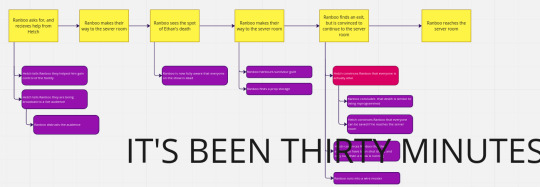
I've spent far too long on this already.
A few notes I did make on the deaths in episode two, for the curious:
Niki was voted by the audience as the first choice to be saved. If the any-person voted was the one to trigger this, Austin, Ethan, or Niki could have died first.
Vinny's death is a cinematic dependency. Unless multiple videos were shot for it, Vinny had to die at that point.
Ethan's death could have been anyone
I'm personally convinced Sneeg was railroaded to survive until the end, given how well his reset state plays off Ranboo's new emotionless performance.
Keep in mind, this is entirely from my own perspective as someone watching from the outside, and approaching it from the perspective of a narrative designer trying to maximise unique outcomes. I've had to make several assumptions here and I could be entirely off-base.
Despite my crashing out, mapping the livestream out like this shows how rail-roaded episode three is, to the point you can actually draw a solid GP for it. It also shows that, even with many golden nodes to hit, episode two manages to have quite a few moments that could have gone differently based on audience choice. At least, if my assumptions are correct.
So, this leaves me with a proposed set of terms for discussing interactive livestream. Interactive livestream are built around "nodes"; chunks of content that have been explicitly planned out and prepared for before the stream begins. Some of these are golden nodes. Golden nodes could be anything, but are things that must be hit before the stream is over. Other nodes may be optionally hit, and entirely unplanned and improvised content can happen between any nodes. During unplanned segments and nodes alike, everyone (and, really, everything), can gain attributes, which can be brought up at any time to the story's discretion.
Maybe these terms are useful. Maybe they aren't. We'll have to wait and see.
The Limitations of Interactive Livestreams
As much as it's fun to speculate what could be, we, unfortunately, live in a real world with restrictions and limits of what we can do.
One of the most obvious ones is budget, and with the amount of moving parts an interactive livestream has, budget becomes a vital topic to remember. But budget isn't just a matter of money. Consider, if you had unlimited money, and were writing a novel by yourself, how fast could you work? Let's say you write a solid 2,000 words a day, and to you, a novel is complete at 80,000. In this example, you're going to live to 80 before peacefully dying of old age, and start your novelist career at the ripe age of 20.
Even if you had no worries about having a roof over your head, feeding yourself, never getting sick, never taking holidays, and sacrificing every day of your life to writing novels, not even accounting for slowing down as you grew older, or editing, publishing, and the entire escapade on getting your work noticed by others, you would be able to produce 547 in your lifetime, with half a manuscript left over.
Now consider this when you do have a limited amount to spend and a deadline to hit, and now you're writing something that could have five novels worth of storylines, involves visuals, audio, music, technical implementation, and now considering interactive livestreams specifically, set design, filming requirements, human needs of catering, sanitation, and shelter for your cast and crew.
Suddenly, two novels of content compared to five looks much more appealing. Interactive narratives not having limitless branches isn't a matter of not wanting to put everything you've got into a project. It's a matter of production realism.
Time is a resource, and one you need to spend just as wisely as money.
This is something very important to remember for interactive livestreams. It's also something to consider for ways we could cut out the expensive parts of one. Could we create one that doesn't have a fancy camera setup? Do we need camera visuals at all, making something akin to a live narrative podcast? Do all interactive livestreams need to last several hours, or can we reduce the scope of time? It wouldn't have the exact same spectacle as a several-hour live filmed show would, sure, but that doesn't mean we can't make impactful narratives with it. Do you know how many eggs we've cracked with 5 minute twine games?
Limitations are also not just a matter of production. We need to think about limitations of a medium itself. A novel, with just text, doesn't have the liberty of showing you something in a visual format, and has to rely entirely on words to communicate the same information. Of course, you can bend and break the rules a little and include pictures in your book, but that starts to cross the line into other formats. Now we're not just a written medium, and have other considerations to make as well. And, generally, writing a paragraph of description is quicker than drawing a picture. The real challenge is making a paragraph just as impactful as a picture in the same spot.
For interactive livestreams, its limitations are a bit tricker to define, being an intersection of so many types of media right off the bat. I'm woefully undereducated of the limitations of filming and live shows, and unfortunately cannot speak to how they would shape how a story is developed. But, what I can do is talk about possible limitations in narrative interactivity. There are a few that jump to mind immediately.
As much as we can talk about audience choice in interactive livestreams, this begs an interesting question, of what happens to the choices the audience doesn't pick. In a game, this is pretty simple. That choice is blocked off, it may have consequences, and the player lives with the choice they did make.
However, games are not performances. They're pieces of media that can be replayed on-demand. If you want a different experience, or want to see what that choice you didn't make actually did, all you have to do is start again.
An interactive livestream does not have this liberty. Once the livestream is over, it cannot be replayed by the audience for a different outcome. Every choice is final, the narrative responds to it, and whatever outcome the then-live audience chooses is the one that's the final outcome for everyone else watching the vod.
In a game, there's often a discussion about how much it should branch around a choice, especially if that choice leads you on an entirely different path with unique content. Someone might not be interested in another run, and unless you really put replayability forward as a selling point, or make it a central mechanic of the game, it's a high gamble that a lot of the content you put a dear amount of effort into will never be seen.
For an interactive livestream, that isn't a matter of content that won't be seen on one run. That's content that won't be seen, period, and is effectively discarded after the stream ends. If we have a story with two immediate branching paths, that's two interactive livestreams worth of budget, for only half the content being delivered.
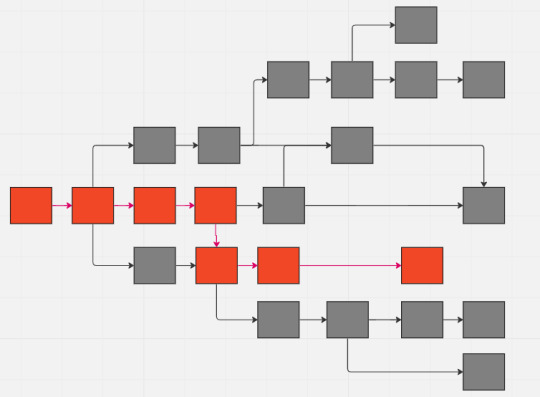
Looking at this diagram, we can see what content someone sees on one run of a typical branching game. There's a lot they saw, but much more that they didn't. Imagine that this is now the planned content branch for an interactive livestream. Imagine that each one of those nodes is the equivalent to a room in episode two of Generation Loss, and how many uncoloured nodes there are in comparison to red.
Are linear bottlenecked choices the only outcomes for narratives of interactive livestream if we're not depending on improv? Is there an upper limit to how much "true" branching you can prepare before you start hitting the limits of your budget? Can there be an interactive livestream that manages to give several ending options based on the path taken, or will it always have to collapse back down to one alone, or an ending with one diverging choice in the final moment? Does this strip some audience agency, knowing that in spite of their choices or "playing along", they will never be able to change where the story is going, or only making one difference right at the end?
Equally, however, the audience will never know. With a game, an inconsequential choice can always be scrutinised on a replay. Finding out that if you choose to shoot someone, you always miss, and gives you the exact same outcome as letting them live. In an interactive livestream, to the audience, that other choice is permanently gone as soon as we decide to let them live. We will never know what shooting them would have done. It's a kind of choice funneling that games could only dream of.
Compare this diagram, showing a heavily bottle-necked story in a game with multiple runs:

To this one. The same story, now adapted for an interactive livestream:

Interactive livestream are already making use of this. Consider the first choice in episode three of Generation Loss. The scripted event is the audience picking one code, and Ranboo picking any other to forward the plot. The "true" code is chosen when the audience picks it, and Ranboo picks a different one to trigger the security lockdown.
In a game, the first time we play this would have much the same narrative impact, but not so on the second. If we pick a code, enter it, and find out on the first run it's wrong, we remember this on the next. We can try to cheat a little and pick the code we know is correct from the previous run, only to find that no matter what, whatever we pick is the incorrect one. Replay value is a little cheapened.
In an interactive livestream, however, as far as the narrative goes, we will never know anything different. Our first choice is the only choice. The yellow code is always incorrect.
Will audiences wise up to these moments and start to tire of it? Will we get good enough at disguising them and striking a balance between actual interactivity and putting the audience on rails? Who knows. We have to do it and find out.
Here's another thing I've been wondering in terms of limitations, of the kind of narrative setups you can and can't do with interactive livestreams. I mention this, because currently the two story-heavy interactive livestreams we have are based around the concept of an audience directly controlling a streamer, who (and in the case of Generation Loss, not at all times) is aware that they're being controlled and broadcast live.
The Dollhouse Stream takes it in a comedic direction. The entire inspiration of the stream is based on The Sims, with Jerma directly taking mannerisms and inside jokes from the games. Jerma is fully aware of the chat controlling him, and at times openly antagonistic of choices made or not made, but always plays into the character and follows whatever decisions the audience makes.
Generation Loss, as discussed, is the horror inversion of this. Ranboo starts blissfully unaware of the audience controlling them, and the fact this is even being broadcast, and plays into it much like they were making the choices themself. Soon after he learns the truth, he's terrified and defiant of the audience previously controlling him, which marks a point in the narrative of things turning south.
It's pretty interesting to me that both of these are built on the audience being in direct control of a streamer as an extant character to itself, and the streamer fully aware it exists, at least in different capacities. It's like we're already having some meta commentary on the whole medium before it's even fully hit its stride.
I'm certain there's ways to create interactive livestream that don't immediately jump to this as how the audience interacts (the first thought takes a similar thread of video games, where the audience "is" the person they're "controlling", and as a character they and the audience are one in the same), but I also posit this. Does the audience need to control a person? Could they control the environment a streamer is in, and possibly the stream itself? Could the audience be an additional character to themselves, not in direct control of others present? Could we hotswap control between different people on the fly? There's room to explore what the audience actually controls and why.
This is also said with an understanding that both The Dollhouse Stream and Generation Loss are, in varying capacities, commentaries on livestreaming and impacts it has on both streamer and audience. This is excellent, and I'm certainly not calling it a dead-end for interactive livestreams, but I am saying that this medium has potential outside it.
And something else I do wonder about, is the tone of narratives in future interactive livestreams. They, obviously, have their roots in streamer culture and the personalities that have come from it. Each of these personalities, being comedic entertainers, always bring their own jokes and riffs and are predisposed to making people laugh from observational humour. It begs the question, will every interactive livestream have some kind of jokes and tangents to it, and all have some form of improv comedy? Will there be ones that manage to break away from this entirely?
But then I think of some criticisms of video games, of saying that things are too "game-like". Which, to me, is similar to walking into an Italian restaurant and complaining about the amount of pasta. Maybe this is similar. I think we simply don't have enough interactive livestreams to call it.
We need to see more.
We're on the Frontier of a New Way to Tell Stories
This is the point where I fully convinced myself of something I'd been suspecting from the first ten minutes of The Dollhouse Stream. By trying to analyse interactive livestreams as interactive fiction, I was met with caveats and exceptions. As a TTRPG, more caveats. As a standard video game, more. This wasn't a simple matter of treating it as one medium, and keeping in mind one adjustment to make it work. There were sweeping knock-on effects that didn't match with any existing interactive media, and forced me to rethink how to approach it from the ground up.
This is how, I believe, interactive livestreams sets themselves apart from other forms of interactive narratives, and into their own category entirely. They are simply something unto themselves. There's many questions here, and they can only be answered by those who will strike out to try them, and I eagerly await those who do.
We are currently seeing, in real time, a new form of interactive media being developed right in front of us. And one I believe, with the right hands and direction, could easily ascend to a point of being considered art through narrative.
I see nothing but potential. There are so many ways to take this medium and I am begging more people to put their hat into the ring to see what the true limits of it are beyond theory and speculation.
But, it needs that direction. It needs people who understand choice in media, and for the love of god, it needs narrative designers at the helm. My obvious bias as a fulltime game designer and solo narrative dev come through here, but there's no other medium that's produced talent better equipped to tackle this.
I'm right here. Someone hire me.
To which my question is: if you're in the games industry, and not instantly smitten by interactive livestreams as a new medium for storytelling experiences, what the hell are you doing?
And if you're not, and read this for whatever reason you did, I hope you can see what I see, and are as excited as I am.
#surprise it's actually today#9.8K WORD WARNING; READ MORE AT OWN RISK#generation loss#gen loss#ranboo#jerma#jerma985#writing#essays#interactive fiction
52 notes
·
View notes
Note
you said klavier eats burgers with only a fork and I imagined him sticking a fork in it dead center and eating the whole thing in one bite like a cartoon
yeah that's exactly what i meant
#ask#anonymous#ik i drew him eating a burger like a normal person in the jerma comic#but like three hours ago i asked myself. what is the worst thing you could do to a burger#surprise! the answer wasn't 'eat it with a knife and fork'#and i thought yeah. klavier would be enough of a freak to eat a burger with a fork and just a fork. probably got it from kristoph
15 notes
·
View notes
Note
how many people nominated jerma? he must've been the real person with the most nominations right?
y’all actually listened to me and didn’t nominate ANY real people, I’m proud :’)
#I haven’t seen any real people#yet#tho if jerma has like 2 or 3 votes I wouldn’t be surprised#transswagcompetition2023
34 notes
·
View notes
Text
Yesterday my professor said “you can work in here after my office hours but you might hear me watching markiplier playing five nights at Freddy’s in the background”
#I love my professors#I love my college .#as hard as college work is#txt#I wouldn’t be surprised if she watched jerma.
11 notes
·
View notes
Text
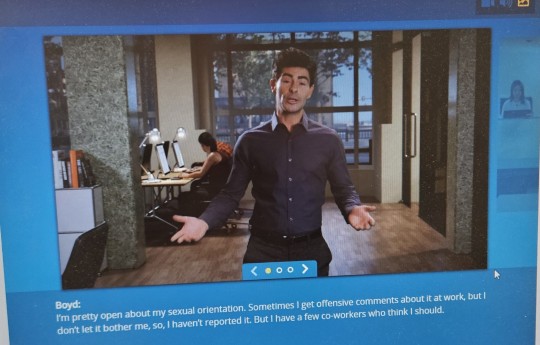




JERMA GUY SPOTTED AT DURING WORK TRAINING....
#i saw him in one picture and was like I Know You From Somewhere......#he was 13 in the 'who will replace me' jerma video....... shocking to see him at work in my computer LMAO#anyways yes yes i know he's an actor & these were almost definitely background work stuff but that doesn't make it any less funny and#surprising to come upon him suddenly when my only association with him is jerma985 LOL
2 notes
·
View notes
Text
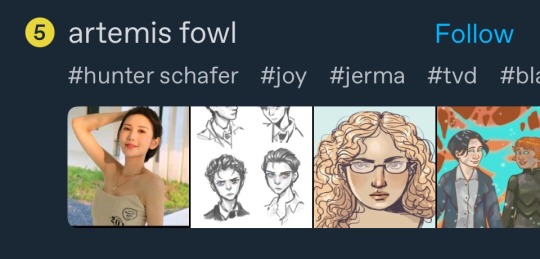
What in the hell??
3 notes
·
View notes
Text
a while back a had a dream where i was in a moving car with toby fox, who was the driver, and some random dude in the back. (this was irl toby not dog toby btw)
he was really really quiet for some reason, and i just decided to pull up a random jerma video on my phone? the guy in the back popped his head up and said "oh yeah toby loves this one!" and toby who had been dead silent the entire time was holding onto the car wheel trying to stop himself from laughing.
and then out of nowhere the dream just transformed into a story about me being a maid for this middle age woman who killed her baby and her mother in a car crash and me having to hide it from her husband.
#the funniest thing about the dream is that my dream self has very shitty memory so the fact that i could remember who toby and jerma was in#the same dream AND the fact that i could remember that toby actually knows who jerma is#is kinda surprising#toby fox#utdr#jerma985#jerma
4 notes
·
View notes
Text
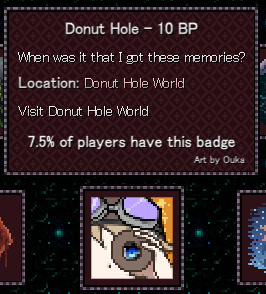
YOOOOOOOOOOOOOOOOO
#art talks about stuff#was literally thinking ''oh hey like the song''#seeing as two of the badges have fucking. jerma references in here this shouldn't have been a surprise#id in alt text
3 notes
·
View notes
Photo



the first two i made yearning and the last one was something june and i both agreed should happen
#🖥 post#jerma should wear a helicopter hat#tbh im surprised he hasn't HAHDKN#he definitely would#and should#homestuck#hal strider#jake english#jakehal#???#haljake#????#jerma#jerma985
86 notes
·
View notes